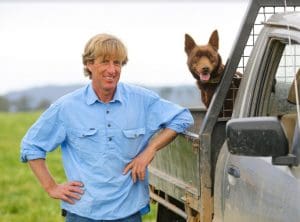
Mark Ritchie and Dot. Picture – Rick Bayne.
MERINO sheep numbers have been lifted in the Ritchie family’s Mansfield operation in the last 12 months, consistent with a counter-cyclical philosophy of managing risk and opportunity.
In the 1990s when gloom surrounded the price of wool, the Ritchie’s at Delatite Station invested in Merinos, moving out of Corriedales. Years later when the cattle market was low they bought more cattle.
“We’re a bit counter-cyclical,” manager Mark Ritchie said.
“Where we see an opportunity to buy or trade stock we do that.
“Often if we’ve seen a market downturn we’ve used that opportunity.”
Click here to get the latest Sheep Central story links sent to your email inbox.
Mr Richie said in the early 1990s, when the reserve price scheme for wool was unwinding, it was all “doom and gloom”, but that was when the family got back into wool.
“Then we increased the size of our cattle herd when we thought the market was at a bit of a low point.”
Mr Ritchie will speak at the Grassland Society of Southern Australia’s annual conference at Nagambie on September 6-7 on managing risk and opportunity. The conference will outline the best ways to invest on-farm to capitalise on good livestock prices.
Mr Ritchie is a fourth generation farmer and manages a self-replacing flock of 18,600 superfine Merino sheep and 1100 Angus cows on 2600 hectares at Mansfield. The farm has been in the family for 110 years. The wool cut averages about 17.7 microns and they use their own rams, or other rams through AI, utilising Australian Sheep Breeding Values and progeny-testing data to ensure matings to help meet breeding objectives. Some older ewes are joined to White Suffolk rams depending on the prime lamb market.
Mr Ritchie said the operation’s Merino sheep numbers go up and down, depending on cattle numbers and labour requirements. The cattle herd has grown with land purchases at times, but over the last 12 months, the beef herd has been cut and the flock has increased by about 2500 in reaction to wool prices.
“We thought that cattle might be at their peak and there might be a bit more strength in the wool market to come.
“We’ve always had two enterprises (sheep and beef cattle); it’s useful to have more than one and in our country we’ve got to have cattle in the system to handle big springs and get on top of the feed,” he said.
“With having two enterprises, you could argue that you are managing some of your risk as well.
“In our experience with benchmarking, wool has always been up there, certainly versus cattle, though it’s a tough industry to be in sometimes, because there is a lot of negative attitude towards wool,” he said.
“But in our experience, wool is a good enterprise to have.”
At the conference, Mr Ritchie will explain how the family approaches risk and opportunity, though he admits what works for one may not work for another.
“Everyone has their own tolerance or appetite for risk,” he said. “No two farmers are the same.”
“For us it’s about taking a long term view and finding a balance between taking calculated risks when the odds are in your favour; backing yourself and looking for opportunities in any situation; whether it’s a strong market or a weak market, a good season or a bad season.”
“You don’t get it right every time,” he added.
The Ritchie family has traditionally discussed options, called on consultants for expert advice but ultimately made the decision themselves.
Recently the strong market for grazing enterprises has led Mr Ritchie to cash in.
“In the last financial year we decided to sell a few extra cattle to capitalise on the prices, and we will again this year if the prices continue.”
The farm has ryegrass and clover pastures with a bit of phalaris and as with stock numbers, Mr Ritchie is always looking for opportunities to improve.
“We’re constantly trying to improve our pastures by sowing more phalaris whenever we can,” he said.
“At Mansfield we have a number of natural advantages that we must exploit; quality soils and a relatively consistent rainfall. We have gone down the path of running a high stocking rate farm with a spring calving self-replacing herd of Angus females plus a spring lambing flock of self-replacing fine wool merinos.”
Mr Ritchie said stocking rate was continually proven to be one of the main drivers of profitability for grazing enterprises.
“Over the years we have spent considerable time, money and effort in maximising our stocking rate and the productivity of our farm, particularly in capital applications of fertiliser and lime, pasture improvement programs, improved genetics, retaining livestock and targeted capital expenditure,” he said.
“We find if the stocking rate is set appropriately and you have one eye on costs and labour efficiency, a low cost of production will follow.”
The season has been good so far but there’s not a lot of moisture in the soil and run-off. “Everyone’s a little bit nervous and hoping for good spring rains,” Mr Ritchie said.
The conference will feature presentations from local practitioners and some of Australia’s best researchers. It will include half day bus trips to visit local farms and the Society’s Annual General meeting.
For all conference enquiries, call the GSSA Office on 1300 137 550, or email [email protected]



HAVE YOUR SAY